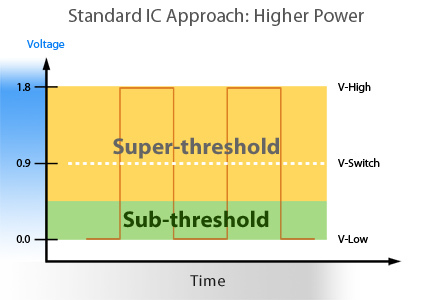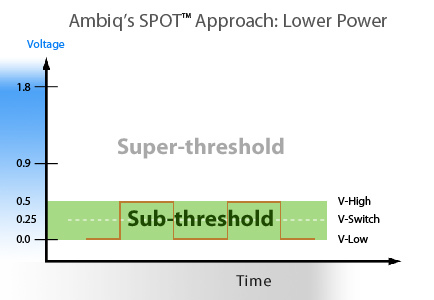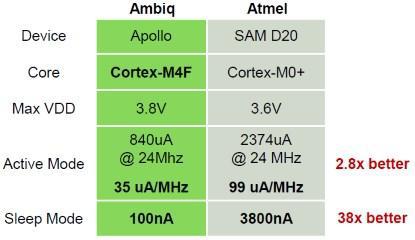Chips with subliminal operating supply voltages - a revolutionary approach to reducing current consumption


Lately, in my work I am constantly confronted with the tasks of reducing the consumption of developed chips. The most popular current solutions are dynamic control of clocking and supply voltage. Those. if this or that chip unit is not required for solving the current task, then clocking is turned off for it, the supply voltage is reduced or completely turned off. Such grandees as Texas Instruments and Renesas are measured by
The energy consumed by the microchip is due to two reasons:
- static leakage current in transistors, even if they do not switch.
- dynamic current required for recharging the capacitance of the chains when switching occurs.
For conventional circuits, a dynamic current prevails during operation, especially for high levels of supply voltage, which are now used. The dependence of current consumption on the supply voltage is shown in the following figure.

')
Since the dynamic current consumption is proportional to the square of the supply voltage, it is the reduction of the supply voltage that is the main key to reducing the overall consumption of the chip (while we have the opposite, but not such dramatic effect of an increase in the static current consumption). For example, if we compare the usual circuit with 1.8V power supply and the circuit operating in the near threshold region by 0.5V, then the dynamic consumption decreases 13 times. And for a circuit operating at a threshold voltage of 0.3V, consumption can be reduced by a factor of 36.
The traditional design of digital microcircuits implies two transistor states - “open” and “closed” - and this is the basis of the concept of digital logic implementation. Analog developers can operate with transistors in amplification mode, i.e. at the threshold of damage. The use of subthreshold voltages means that the transistor will never be "open". And thus the “logical unit” will correspond to a practically indistinguishable from a “closed” state of the transistor. And this means that the implementation of microchips according to this scheme requires new approaches and solutions.
Subthreshold solutions have been known for several decades.
Designing circuits with subliminal supply voltages is not something supernova. Back in the 70s, Swiss watchmakers noticed the potential of using transistors in a subliminal mode. This idea is used for pacemakers and RFID tags, but so far, in addition, it has not been used anywhere else. After a lull that lasted several decades, this topic regained academic interest in the late 90s and early 2000s. By this time, the value of current consumption in commercial electronics became apparent, and research began on various methods to reduce current consumption. The Ambiq founders were part of these academic studies when they worked at the University of Michigan. The main focus of their research was the commercialization of this technology.
The question arises, why if the opportunity to work with subliminal supply voltages has been known since the 70s, then it still does not apply. It is possible that the disadvantages of this approach do not allow it to be used under normal conditions. Simply put: “If it’s so simple, then why don’t everyone do it?” The answer is simple: “Because it’s not very easy.” There are no fatal flaws in this technology, but the transition to methods of working with subthreshold supply voltages is not trivial. You can also ask what has changed since the 70s, when the first subliminal commercial devices appeared. First of all, the scale has changed. Older designs used a maximum of several dozen transistors operating in a subliminal mode, and such a circuit could be calculated and optimized manually. Now microcircuits contain millions of transistors. It is impossible to calculate such a scheme manually, and for their development it is necessary to use standard software tools that are primarily aimed at working with standard suprathreshold logic. And the adaptation of standard tools and approaches for working with subliminal supply voltages allowed Ambiq to commercialize this technology.
Subliminal problems
Adaptation of standard supra-threshold approaches for the design of circuits with sub-threshold supply voltage have several key problems.
Bad transistor models
The transistor model is the basis of everything in the development of modern microelectronics. All simulators, all abstractions and automation of the entire development process are tied to the accuracy of the transistor model.

Most modern transistor models focus on its operation at high supply voltages, i.e. they fairly accurately describe his eating behavior well above the threshold. But when powered from 0V to the threshold, these models do not work at all or give out inadequate data.
Logic switch and noise
In the subliminal mode, a change in the current through the transistor during the transition from the “open” to the “closed” state and back requires greater sensitivity to detect. And although the currents vary exponentially from voltage changes, they still remain extremely small. In the subliminal mode, the current through the "open" transistor is only 1000 times the current of the "closed" transistor, while for the normal mode this ratio exceeds several million. Thus, external noise is much easier to distort the operation of the circuit.

Sensitivity to operating conditions
The sub-threshold mode of operation of the transistor is also much more sensitive to deviations of the manufacturing process and environmental conditions. For example, if the process of making crystals is deflected to the slow side, the current through the transistor will be 10-100 times less than in a typical process. Taking into account the fact that the ratio of “open” and “closed” currents is about a thousand, this change cannot be ignored.

Temperature drops also have a huge impact on transistor currents. In this case, the changes in the currents in the subliminal mode are orders of magnitude greater than the changes in the currents in the normal mode. Thus, when developing a circuit using sub-threshold supply voltages, developers need additional efforts in order for the circuit to work under various operating conditions.
Infrastructure issues
The modern microcircuit production process is based on the use of above-threshold supply voltages, and stop working when applied under threshold technology. This is associated with various problems, for example, test setups and measuring devices with the help of which manufacturing processes are controlled do not have sufficient accuracy required for operation with under threshold supply voltages. These measuring devices allow you to measure microamps, and you need nano-and even pico-ampere ranges.
Even the set of characteristics of circuits at subliminal supply voltage must be rethought with respect to traditional circuits. A typical set of properties may not be sufficient to prove that a circuit with a subthreshold supply voltage will work completely correctly in all modes of operation.
Ambiq Solution
The technology developed by Ambiq SPOT allows a better understanding of the transistor behavior under these conditions. Ambiq has described some selected set of transistors from conventional manufacturing technology for subliminal operation. With this characterization, a large number of transistors of the same type were measured in order to obtain qualitative statistical data on the variation of parameters, this is necessary in order to detect and understand the various effects caused by the deviation of the manufacturing process, the influence of the environment.
After the qualitative models of transistors were obtained on their basis, a library of standard digital cells was developed that can work in a subthreshold mode. This library is also carefully researched and characterized. When developing a library of standard cells, we had to solve two mutually exclusive tasks - we had to make circuits with extremely high sensitivity, while minimizing the cell's own consumption.
Development of analog circuits require additional effort. While the development of digital cells for the subliminal mode was largely built on the processing of existing solutions, the development of analog units requires other circuit solutions that are fundamentally different for those that are commonly used. When developing circuits with subliminal levels of nutrition, there are no general approaches suitable for all cases. In some cases, the implementation of the circuit on the subliminal mode of the transistors was not possible, and transistors had to be used in normal mode with normal power, and the use of such circuits in small quantities does not greatly affect the overall consumption. A good example of this is non-volatile memory, which stores settings and calibration factors while the device is turned off. When the power is turned on, the circuit starts to operate in a mode with power above the threshold. After the adjustment is completed and the calibration coefficients are copied to the nastoyechny registers, the power is reduced to the sub-threshold level, and the non-volatile memory is no longer used. In cases where increased performance is required and the sub-threshold voltage is not enough to ensure the required speed, the voltage can be raised to a threshold level or even higher. Obviously, in this case, consumption is also increasing. Also, for the stable operation of the circuit, it is necessary to dynamically track external factors, such as temperature, for example, and depending on them, to rebuild the operating modes of subthreshold circuits to ensure their high-quality operation.
A lot of effort has been spent on what would work technology in subliminal modes to ensure performance in the framework of standard processes for the manufacture of crystals. Special processes for the manufacture of crystals could make life easier, but they greatly increased the cost of manufacture. Ambiq technology works in processes that are already well known and tested and are widely used.
The development process is based on a special library characterized for special conditions of work in subthreshold modes. This process largely repeats the tasks that arise when developing a circuit for the 28-nm process. Ambiq just did the same for simpler and more affordable technologies, which significantly reduced consumption.
A lot of attention was paid to the problems of circuit testing. As the usual measuring equipment cannot measure the chip consumption with sufficient accuracy. Also, screening testing of microcircuits requires more thoroughness than is customary for microcircuits, since it is required to measure the microcircuit in a greater number of combinations of external conditions.
In general, all stages of the development of microcircuits were rethought and changed to ensure the efficiency of the circuit in subliminal mode and reduce the current consumption. Development of schemes for new technology requires that they be verified that they work for a long time life. For hardware developers, the reliability of microcircuits is an equally important parameter along with consumption. Therefore, the Ambiq chips were subjected to a whole series of tests for reliability, including under the conditions of extreme external factors. This includes other standard tests, such as static resistance. All tests have proven that the chips have the necessary reliability.
Conclusion
Currently, Ambiq has already released a series of real-time clock chips with no more than 55 nA. And it plans to start production of Apollo series microcontrollers with extremely low consumption of 30 μA / MHz.
The main characteristics of Apollo microcontrollers:
- Over low power consumption in active mode 30 µA / MHz
- Over low power consumption in sleep mode 100 nA (RTC on)
- High-performance core ARM Cortex-M4F
- Clock frequency up to 24 MHz
- Program memory up to 512 Kbytes of Flash
- Data memory up to 64 KB
- ADC 10 bit, 13 channels with speeds up to 1 MSa / s
- Standard peripherals set I2C, SPI, UART
- Power supply from 1.8V to 3.8V
- Compact enclosures 64 pin BGA and 42 pin CSP
Comparing Apollo microcontroller with other microcontrollers:


The comparison was conducted on the test Coremark.
Based on:
Source: https://habr.com/ru/post/257067/
All Articles